Posting some research papers and news about paleontology and nature for people to go read.
Don't wanna be here? Send us removal request.
Text
Paleozoic cave system preserves oldest-known evidence of amniote skin
Published 11th January 2024
The first record of a skin-cast fossil from the Paleozoic Era and the earliest known occurrence of epidermal integumentary structures within the infilled cave system of Richards Spur, Oklahoma. The preserved material provides insights into the evolution of skin during the transition from aquatic to fully terrestrial environments by early amniotes.

Articulated skeleton of Captorhinus aguti with preserved linear integumentary structures above the vertebral column, this structure is interpreted as skin

Three-dimensional skin cast and compression fossils from unknown amniotes

Lepospondyl, temnospondyl, and unknown tetrapod dermal scales
Source:
6 notes
·
View notes
Text
A giant tyrannosaur from the Campanian–Maastrichtian of southern North America and the evolution of tyrannosaurid gigantism
Published 11th January 2024
Discovery of a new tyrannosaurin, Tyrannosaurus mcraeensis, based on a fossil from the Hall Lake Formation of New Mexico previously referred to as Tyrannosaurus rex. Tyrannosaurus mcraeensis predates Tyrannosaurus rex by ~ 6–7 million years, yet they were similar sizes, Phylogenetic analysis leads to Tyrannosaurus mcraeensis as sister to Tyrannosaurus rex and indicates that Tyrannosaurini originated within southern Laramidia.

Locality and stratigraphy of Tyrannosaurus mcraeensis, reconstruction of cranial elements and silhouette; Cranial elements of Tyrannosaurus mcraeensis holotype
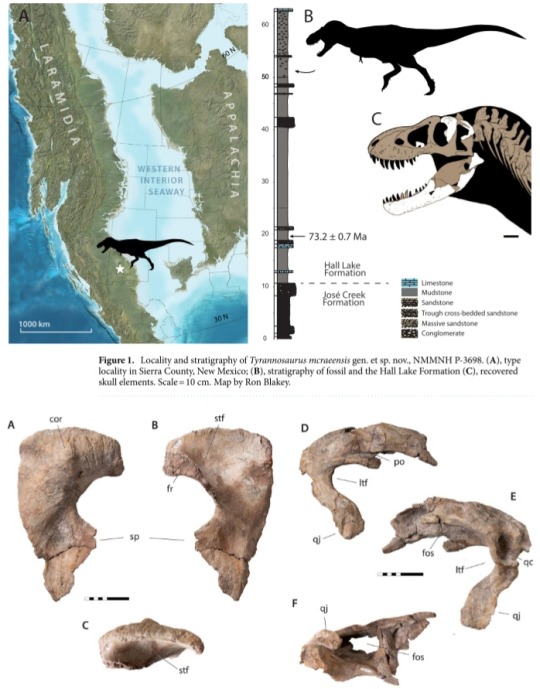
Mandibular elements of Tyrannosaurus mcraeensis holotype
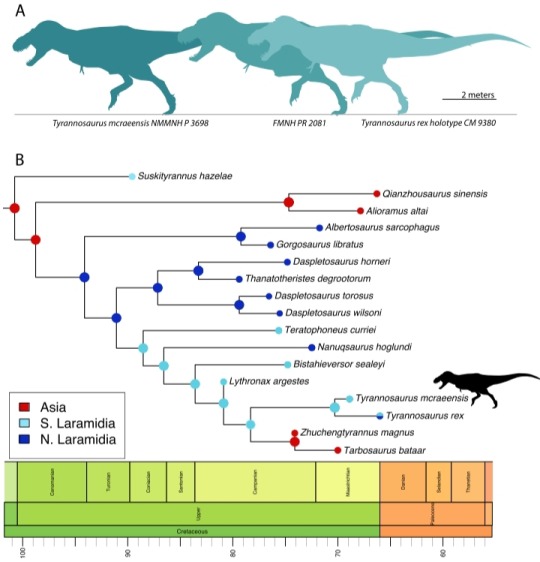
phylogenetic anaylsis of Tyrannosaurus mcraeensis
Source:
(I'm back from a break, enjoy reading this great publication! It took a few years to make so support the team who worked on this and click on the link if you're interested.)
#paleontology#fossil#prehistoric#extinct#science#dinosaur#dinosaurs#new species#tyrannosaurus rex#tyrannosaurid#t rex#Tyrannosaurus mcraeensis
21 notes
·
View notes
Text
A new toothless pterosaur from the Early Cretaceous Jehol Biota with comments on the Chaoyangopteridae
Published 21st December 2023
A new species of azhdarchoid Chaoyangopterid is described based on 2 specimens from the Jiufotang Formation in China, named Meilifeilong youhao. This new species represents the most complete and well-preserved chaoyangopterid ever, including rarley preserved ear material and a nearly complete skull.
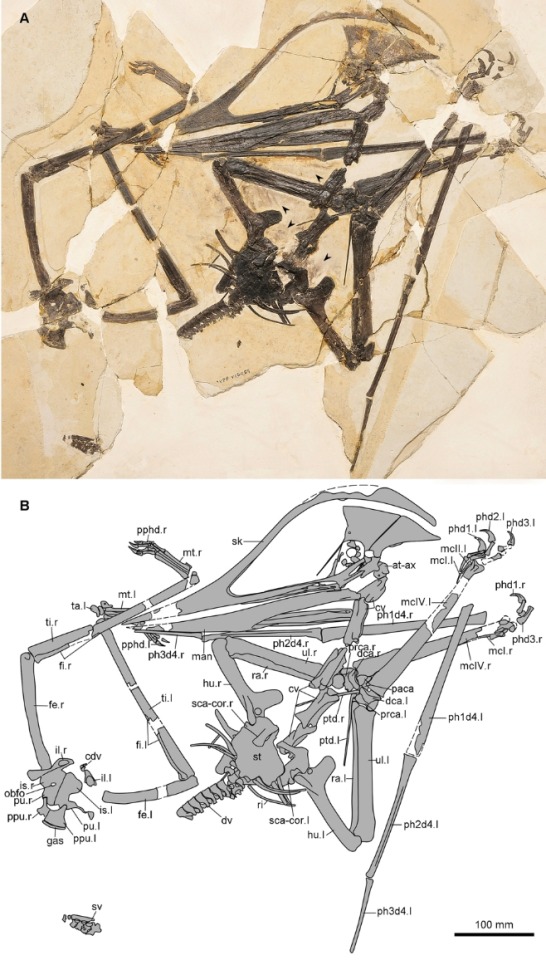
Photo and line drawing of Meilifeilong youhao holotype

Second known specimen of Meilifeilong youhao
Source:
12 notes
·
View notes
Text
A new gigantic titanosaurian sauropod from the early Late Cretaceous of Patagonia (Neuquén Province, Argentina)
Published 18th December 2023
A new gigantic titanosaur is described based on 4 specimens from the Neuquén Province in Argentina, named Bustingorrytitan shiva, the species is measured to be 67.297 metric tons thus making it the largest sauropod ever recorded.

Holotype and paratype material of Bustingorrytitan shiva vertebrae and dentary

phylogenetic anaylsis of Bustingorrytitan shiva
source:
12 notes
·
View notes
Text
Thoracic and abdominal outgrowths in early pterygotes: a clue to the common ancestor of winged insects?
Published 12th December 2023
New features from the palaeodictyopteran larvae of several different instars ,fossil specimens from the late Carboniferous at Piesberg in Germany, representing a newly described species, Katosaxoniapteron brauneri, proposed to live a aquatic or semi-aquatic lifestyle and providing possible indication for the early evolution of the ancestors of winged insects.

Larval exuviae of various instars of Katosaxoniapteron brauneri and holotype material(A)

Prothoracic lobes and meso- and metathoracic wing pads of exuviae of larvae of Katosaxoniapteron brauneri

Katosaxoniapteron brauneri gen middle instar larva reconstruction
Source:
2 notes
·
View notes
Text
Moulting behaviour in the trilobite Oryctocephalus indicus (Reed, 1910) from the Cambrian Miaolingian Series (Wuliuan Stage) of Jianhe, South China
Published 12th December 2023
Investigation of the configuration, style, and process of moulting in Oryctocephalus indicus through analysis of 88 fossils from the Kaili Formation in Guizhou Province, South China.

Examples of Henningsmoen’s configuration in Oryctocephalus indicus

Reconstruction of moult process for Oryctocephalus indicus based on specimens
Source:
6 notes
·
View notes
Text
Exceptionally preserved stomach contents of a young tyrannosaurid reveal an ontogenetic dietary shift in an iconic extinct predator
Published 8th December 2023
Description of a remarkable specimen of a juvenile Gorgosaurus libratus that preserves other dinosaur remains inside its abdominal cavity, providing evidence for tyrannosaurids occupying both mesopredator and apex predator roles during their life span.

Juvenile Gorgosaurus specimen with simple line drawing and Histological photomicrograph of the tibia

Stomach contents of juvenile Gorgosaurus
source:
21 notes
·
View notes
Text
Restudy of shoulder motion in the theropod dinosaur Mononykus olecranus (Alvarezsauridae)
Published 5th December 2023
Investigation of the range of motion at the shoulder in Mononykus olecranus is conducted by measuring the angle of the humerous. Results show that Mononykus olecranus was able to tuck its arms in at the sides allowing them to sprawl to orient the palm downward ,enabling a hook-and-pull digging at surfaces to forage for insects.

Experimental setup and Range of humeral motion in Mononykus olecranus
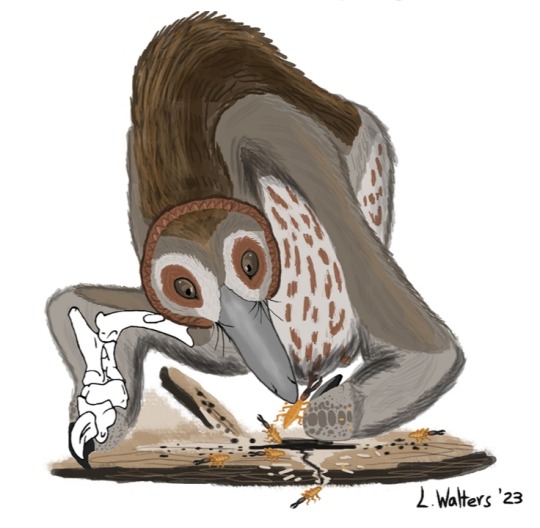
Life reconstruction of Mononykus olecranus foraging for termites in some wood, artwork by Leandra Walters
Source:
12 notes
·
View notes
Text
The earliest fossil mosquito
Published 4th December 2023
The discovery of 2 conspecific male mosquitoes with piercing mouthparts named as a new species, Libanoculex intermedius, preserved in amber dating back to the Early Cretaceous from Lebanon, these specimens mark the earliest fossil mosquito and provide insights for early mosquito evolution.

Holotype of Libanoculex intermedius

phylogenetic anaylsis of Libanoculex intermedius
Source:
12 notes
·
View notes
Text
Enamel microstructure and dental histology in a heterodontosaurid dinosaur: Heterodontosaurus tucki
Published 1st December 2023
Researchers investigate the histology and enamel microstructure of Heterodontosarus tucki maxillary cheek teeth using SEM anaylsis. Results reveal the specimen possessed relatively typical ornithischian enamel schmelzmuster on the mesial and distal edges of the maxillary teeth as well as thin enamel and simplified microstructure indicating the enamel is largely non-functional as a shearing crest; this histological structure represents the chronologically and phylogenetically earliest known acquisition of wear-resistant modified dentine in ornithischians and the earliest occurrence of its presence on the occlusal surface in dinosaurs.
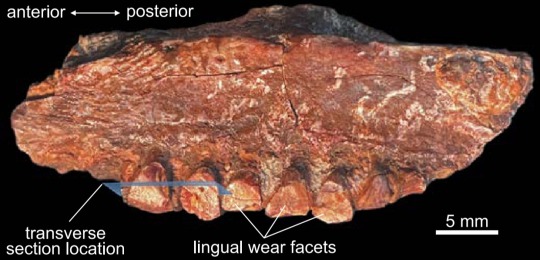
Heterodontosaurus tucki (BP/1/9007) Left partial maxillary tooth row
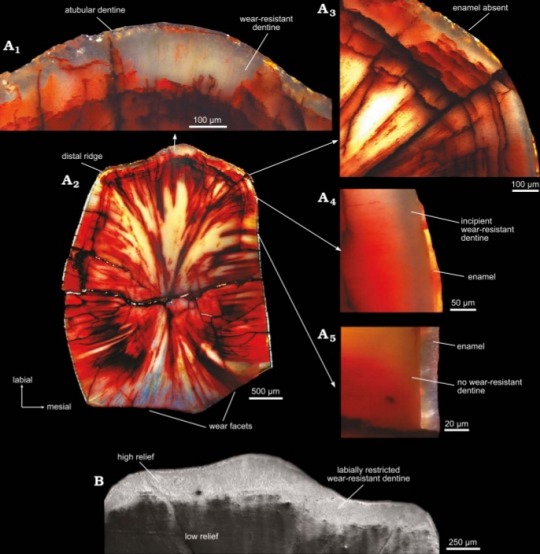
Maxillary tooth histology of Heterodontosaurus tucki, (A) Histological sections, (B) SEM of tooth
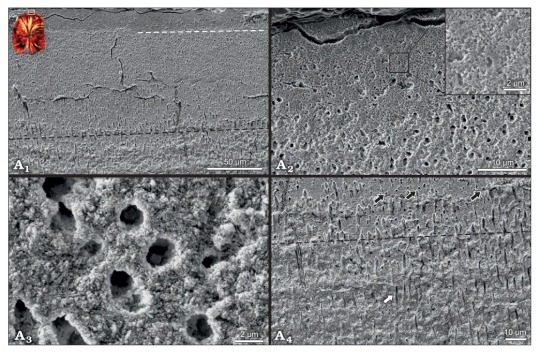
SEM images of histologically distinct dentine on the outer labial edge of maxillary teeth of Heterodontosaurus tucki
Source:
6 notes
·
View notes
Text
A new platyrostrine sperm whale from the Early Miocene of the southeastern Pacific (East Pisco Basin, Peru) supports affinities with the southwestern Atlantic cetacean fauna
Published 30th November 2023
A partial sperm whale skull from Lower Miocene of the Chilcatay Formation in Peru is assigned to a new species, Diaphorocetus ortegai, providing new insights for the macroraptorial Diaphorocetus family.

Cranium of Diaphorocetus ortegai holotype

Cranium of Diaphorocetus ortegai holotype

Time-calibrated strict consensus tree of Diaphorocetus ortegai
Source:
https://sciencepress.mnhn.fr/en/periodiques/geodiversitas/45/22
7 notes
·
View notes
Text
Re-analysis of a dataset refutes claims of anagenesis within Tyrannosaurus-line tyrannosaurines (Theropoda, Tyrannosauridae)
Published 28th November 2023
Phylogenetic reanalysis of Daspletosaurus wilsoni reveals a cladogenetic Tyrannosaurinae composed of four morphologically and biogeographically distinct clades that are formally defined and diagnosed (Teratophoneini clade and Tyrannosaurini).
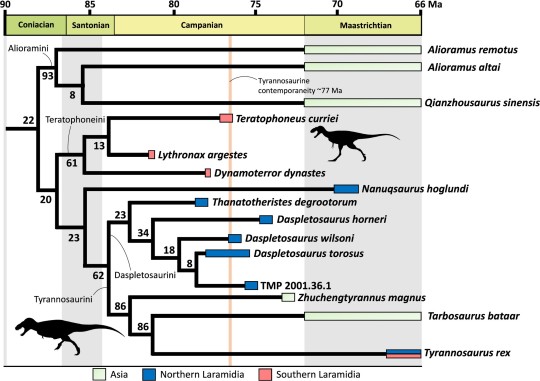
Cladistic analyses strict consensus phylogeny of Tyrannosaurinae
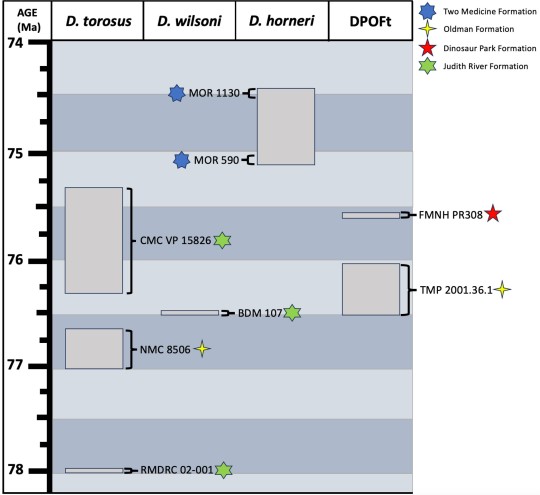
Stratigraphic distribution of the species of Daspletosaurus
Source:
3 notes
·
View notes
Text
FIRST RECORD OF AN ABELISAURID (DINOSAURIA, THEROPODA) NATURAL ENDOCAST, AND COMMENTS ON SKULL ROOF ORNAMENTATION
Published 18th November 2023
The second natural endocast described for a dinosaur in Argentina and the first for a theropod, as well as 2 associated skull roofs, is assigned to an Abelisaurid from the Bajo de la Carpa Formation in Neuquén Province, Northern Patagonia. The relative size of the cranial specimens is interpreted as similar to that of Llukalkan, however the marked reduction of ornamentation in the associated skull roofs indicates a distinctive pattern that differentiates them from Llukalkan and Viavenator. It is possible the described cranial elements represent a new species of small bodied albelisaurid, potential sexual dimorphism or a juvenile individual of a known species; it is unknown what these remains represent currently.

MAU-Pv-CO-725, Albelisaurid natural cranial endocast


MAU-Pv-LE-620 and MAU-Pv-CO-725, albelisaurid skull roof and detail of the frontal ornamentation formed by pits
Source:
12 notes
·
View notes
Text
Two new species of small-bodied pachycephalosaurine (Dinosauria, Marginocephalia) from the uppermost Cretaceous of North America suggest hidden diversity in well-sampled formations
Published 16th November 2023
Two new small-bodied pachycephalosaurines, Sphaerotholus lyonsi and Sphaerotholus triregnum, are discovered: one from the Dinosaur Park Formation in Alberta and the other from the Hell Creek Formation in Montana, both represented by an isolated squamosal.

Holotype left squamosal of Sphaerotholus triregnum

Holotype left squamosal of Sphaerotholus triregnum
Source:
23 notes
·
View notes
Text
A new alvarezsaurid dinosaur (Theropoda, Alvarezsauria) from the Upper Cretaceous Baruungoyot Formation of Mongolia provides insights for bird-like sleeping behavior in non-avian dinosaurs
Published 15th November 2023
A newly described derived alvarezsaur, Jaculinykus yaruui, from the Late Cretaceous of Mongolia represented by a nearly complete and articulated skeleton with the preserved posture of a stereotypical avian-like sleeping position suggesting that the sleeping postures are a maniraptoran synapomorphy.
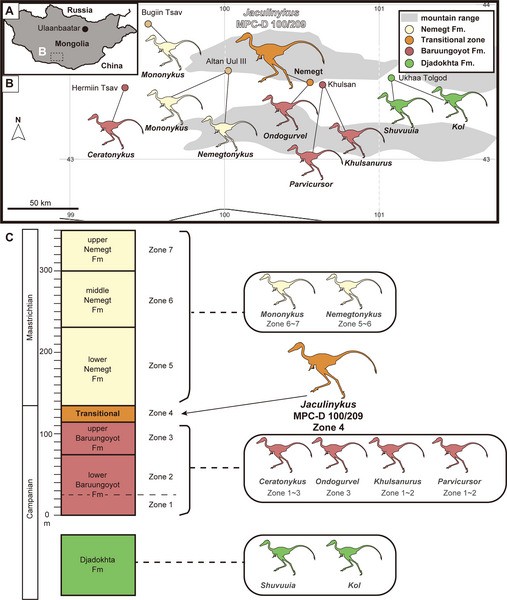
Geographic and stratigraphic occurrence of the Mongolian alvarezsaurids and Jaculinykus yaruui
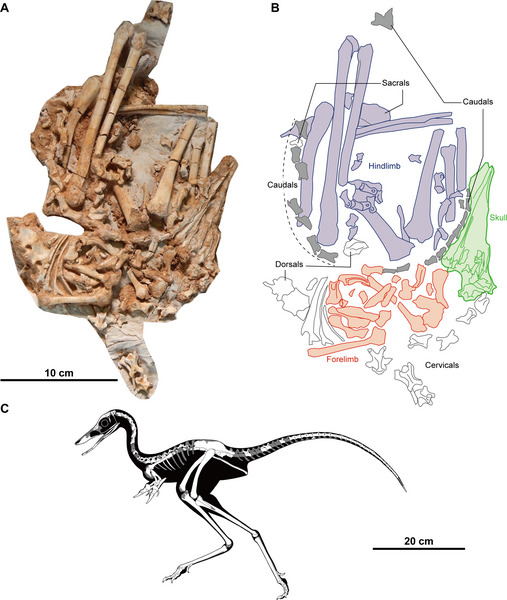
Holotype of Jaculinykus yaruui and skeletal reconstruction

Evolution of avian-like sleeping posture in theropod dinosaurs, Skeletal disposition of Jaculinykus yaruui and life reconstruction
Source:
4 notes
·
View notes
Text
Bite and tooth marks on sauropod dinosaurs from the Morrison Formation
Published 14th November 2023
Researchers survey fossil collections cataloging 68 sauropod bones from the Upper Jurassic Morrison Formation of the USA that bear bite traces that can be attributed to theropods, the observed bite traces show no signs of healing indicating predation or scavenger behaviour.
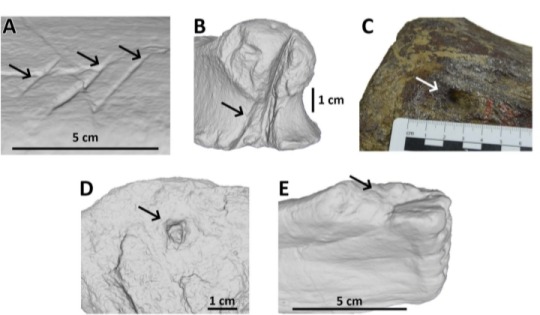
Examples of bite traces on Morrison Formation sauropod elements

Bite traces on a sauropod neural spine of Apatosaurus
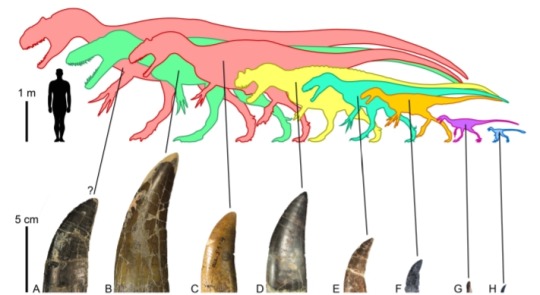
Morrison Formation theropods and their tooth crowns, (A)Allosaurus, (B)Torvosaurus tanneri, (C) Allosaurus, (D) Ceratosaurus, (E) Marshosaurus bicentessimus, (F)Tanycolagreus topwilsoni, (G)Ornitholestes hermanni, (H)Hesperornithoides miessleri
source:
30 notes
·
View notes
Text
Trophic relationships in the Early Miocene Upper Marine Molasse of Baden-Württemberg, Southwest Germany, with special emphasis on the elasmobranch fauna
Published 10th November 2023
Reseachers present a fresh and comprehensive palaeoecological reconstruction of the Early Miocene Upper Marine Molas ecosystem in Baden-Württemberg with a focus on the elasmobranch fauna to determine the trophic relationships, using fossil teeth as proxies for diet and trophic levels based on functional morphology and an actualistic species- or genus-level approach.

New lithostratigraphic terminology for the Ottnangian deposits of the Upper Marine Molas in Southwest Germany

Map showing the fossiliferous localities
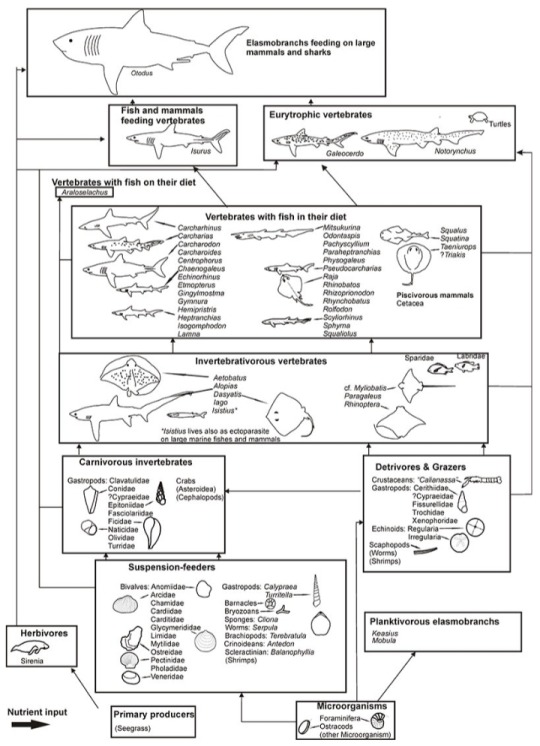
Generalized trophic interaction scheme of the five Upper Marine Molas deposits
source:
https://doi.org/10.26879/1233
5 notes
·
View notes